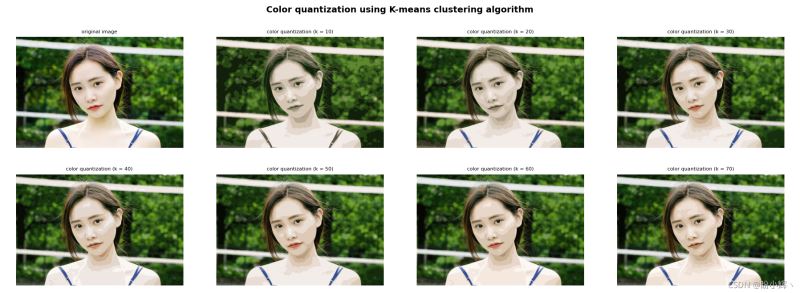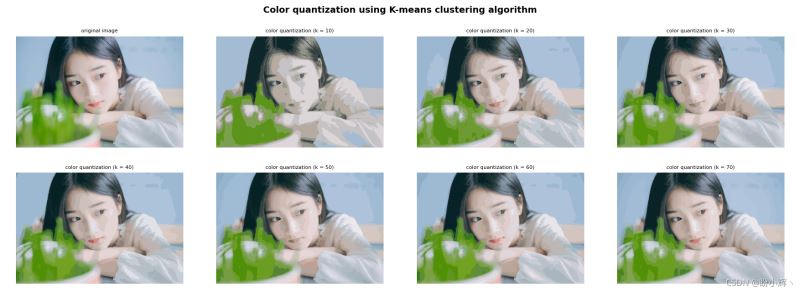您好,登錄后才能下訂單哦!
您好,登錄后才能下訂單哦!
小編給大家分享一下Python+OpenCV中如何利用K-Means 聚類進行色彩量化,相信大部分人都還不怎么了解,因此分享這篇文章給大家參考一下,希望大家閱讀完這篇文章后大有收獲,下面讓我們一起去了解一下吧!
色彩量化問題可以定義為減少圖像中顏色數量的過程。色彩量化對于某些設備顯示圖像非常關鍵,這些設備可能由于內存限制等原因只能顯示有限顏色,因此,在這些設備上顯示色彩通常需要在準確性和減少顏色數量之間進行權衡,在利用 K-Means 聚類進行色彩量化時,權衡兩者是通過正確設置 K 參數來進行的。
利用 K-Means 聚類算法來執行色彩量化,簇中心數據由 3 個特征組成,它們對應于圖像每個像素的 B、G 和 R 值。因此,關鍵是將圖像轉換為數據:
data = np.float32(image).reshape((-1, 3))
為了觀察如何權衡準確性和顏色數,我們使用不同 K 值 (3 、 5 、 10 、 20 和 40) 執行聚類過程,以查看生成的圖像如何變化,如果我們想要只有 3 種顏色 (K = 3) 的結果圖像,需要執行以下操作:
加載 BGR 圖像:
img = cv2.imread('example.jpg')使用 color_quantization() 函數執行色彩量化:
def color_quantization(image, k): # 將圖像轉換為數據 data = np.float32(image).reshape((-1, 3)) # 算法終止條件 criteria = (cv2.TERM_CRITERIA_EPS + cv2.TERM_CRITERIA_MAX_ITER, 20, 1.0) # K-Means 聚類 ret, label, center = cv2.kmeans(data, k, None, criteria, 10, cv2.KMEANS_RANDOM_CENTERS) # 簇中心 center = np.uint8(center) # 將具有 k 顏色中心的圖像轉換為 uint8 result = center[label.flatten()] result = result.reshape(img.shape) return result color_3 = color_quantization(img, 3)
color_quantization() 函數中,關鍵點是利用 cv2.kmeans() 方法。最后,可以用 k 種顏色來構建圖像,用它們對應的中心值替換每個像素值,程序的運行結果如下所示:


利用 K-Means 聚類進行色彩量化的完整代碼如下所示:
import numpy as np
import cv2
from matplotlib import pyplot as plt
def show_img_with_matplotlib(color_img, title, pos):
img_RGB = color_img[:, :, ::-1]
ax = plt.subplot(2, 4, pos)
plt.imshow(img_RGB)
plt.title(title, fontsize=8)
plt.axis('off')
def color_quantization(image, k):
# 將圖像轉換為數據
data = np.float32(image).reshape((-1, 3))
# 算法終止條件
criteria = (cv2.TERM_CRITERIA_EPS + cv2.TERM_CRITERIA_MAX_ITER, 20, 1.0)
# K-Means 聚類
ret, label, center = cv2.kmeans(data, k, None, criteria, 10, cv2.KMEANS_RANDOM_CENTERS)
# 簇中心
center = np.uint8(center)
# 將具有 k 顏色中心的圖像轉換為 uint8
result = center[label.flatten()]
result = result.reshape(img.shape)
return result
fig = plt.figure(figsize=(16, 8))
plt.suptitle("Color quantization using K-means clustering algorithm", fontsize=14, fontweight='bold')
# 圖片加載
img = cv2.imread('example.png')
show_img_with_matplotlib(img, "original image", 1)
# 使用不同 K 值進行色彩量化
for i in range(7):
color = color_quantization(img, (i+1) * 10)
show_img_with_matplotlib(color, "color quantization (k = {})".format((i+1) * 10), i+2)
plt.show()可以擴展以上程序使其顯示色彩量化后的色彩分布,該色彩分布顯示了分配給每個聚類中心的像素數。只需擴展 color_quantization() 函數已被修改為包含所需功能:
import collections def color_quantization(image, k): # 將圖像轉換為數據 data = np.float32(image).reshape((-1, 3)) # 算法終止條件 criteria = (cv2.TERM_CRITERIA_EPS + cv2.TERM_CRITERIA_MAX_ITER, 20, 1.0) # K-Means 聚類 ret, label, center = cv2.kmeans(data, k, None, criteria, 10, cv2.KMEANS_RANDOM_CENTERS) # 簇中心 center = np.uint8(center) # 將具有 k 顏色中心的圖像轉換為 uint8 result = center[label.flatten()] result = result.reshape(img.shape) # 統計分配給每個聚類中心的像素數 counter = collections.Counter(label.flatten()) print(counter) # 計算輸入圖像的總像素數 total = img.shape[0] * img.shape[1] # 為色彩分布圖像指定寬度和高度: desired_width = img.shape[1] desired_height = 70 desired_height_colors = 50 # 初始化色彩分布圖像 color_distribution = np.ones((desired_height, desired_width, 3), dtype='uint8') * 255 start = 0 for key, value in counter.items(): # 歸一化 value_normalized = value / total * desired_width end = start + value_normalized # 繪制與當前顏色對應的矩形 cv2.rectangle(color_distribution, (int(start), 0), (int(end), desired_height_colors), center[key].tolist(), -1) start = end return np.vstack((color_distribution, result))
上述代碼中,使用 collections.Counter() 來統計分配給每個聚類中心的像素數:
counter = collections.Counter(label.flatten())
例如,如果 K = 10,則可以得到如下結果:
Counter({7: 37199, 3: 36302, 0: 29299, 5: 23987, 6: 23895, 1: 20077, 9: 19814, 8: 18427, 4: 16221, 2: 14779})構建色彩分布圖像后,將其與色彩量化后的圖像連接在一起:
np.vstack((color_distribution, result))
程序的輸出如下所示:

從上圖可以看出,使用 K-Means 聚類算法應用色彩量化后改變參數 k (10、20、30、40、50、60 和 70) 的結果,k 值越大產生的圖像越逼真。
Note:除了 color_quantization() 函數外,由于其他代碼并未修改,因此不再另外給出。
以上是“Python+OpenCV中如何利用K-Means 聚類進行色彩量化”這篇文章的所有內容,感謝各位的閱讀!相信大家都有了一定的了解,希望分享的內容對大家有所幫助,如果還想學習更多知識,歡迎關注億速云行業資訊頻道!
免責聲明:本站發布的內容(圖片、視頻和文字)以原創、轉載和分享為主,文章觀點不代表本網站立場,如果涉及侵權請聯系站長郵箱:is@yisu.com進行舉報,并提供相關證據,一經查實,將立刻刪除涉嫌侵權內容。